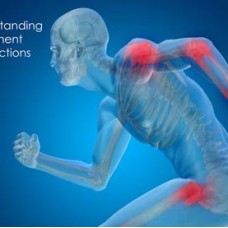Understanding Common Movement Dysfunctions Home Study Course
- Are you prepared and confident to work with and train a client with a
previous injury or completed physical therapy? Do you have the confidence
and skillset to train post rehabilitative clients? This course will teach
you about common orthopedic injuries and movement dysfunctions of the
ankle, knee, hip, shoulder and spine. Including common medical treatment,
physical therapy received and stages of rehabilitation. In addition, learn
about common neuromuscular, cardiopulmonary and special population conditions.
Understand the principles of post rehabilitation training.
Learn how to work with clients with a history of an injury. This course
will teach you how to design safe and effective programs, understanding
the ‘why’ behind exercise prescription and selection, helping your clients
reach optimal wellness safely.
Common Movement Dysfunctions of the Orthopedic, Neuromuscular, CP/CV
and Special Populations Course
This course is approved by the following agencies:
IHFA 3.0
BCRPA 3.0
CFES 3.0 CEC’s
HFPA 20 CPD points for all five courses
ISSA 1.0
NAFC .4
NCCPT .4
NASM .4
NFPT .5
NSCA (CSCS and CPT) .4
NSPA
3 CEUs
PTA Global 4 CEC’s
WFA .5 or 2.5 for completion of all five courses
WITS
4 CEU's
The course is offered to you in a distance-learning format providing advanced
continuing education to personal trainers.
PTCS will send you the course electronically and is available for immediate
download after purchase.
*Note you have 6 months to complete the unit and all examination costs are
included
Course
Overview:
This course begins with reviewing the reasons how a
dysfunction(pathology)develops. Next, common orthopedic and neuromuscular
conditions are reviewed. Including the pathophysiology/mechanism of injury,
common signs & symptoms, medical management and post therapy training with
rationale. Next common cardiopulmonary/cardiovascular and special population
conditions are reviewed. Lastly, common vestibular conditions are reviewed
providing additional insight for the personal trainer. In sum, this is an ideal
resource for personal trainers who truly want to understand the science behind
the movement and the wish to work effectively with any client.
Course Materials:
This
package with online test includes a 79-page manual and 28-page workbook in PDF
format. Included within the course and workbook are two practice examinations
testing the reader’s comprehension of the material. Note: This course package
is made available for immediate download after purchase. All materials for this
course are received electronically. Nothing is mailed.
Course Objectives:
1. Understand and learn about common orthopedic, neuromuscular,
cardiopulmonary/vascular and special population dysfunctions of the upper and lower
body occur in extensive detail.
2. Review the pathology/movement dysfunction, mechanism of injury, common
symptoms, medical management, common physical therapy treatment and post
therapy training with recommendations based on evidenced based research and
practical application.
3. Identify with common orthopedic movement dysfunctions such as ACL
reconstruction, TKR, THR, RTC repair, etc. 1-3 exercises that are
contraindicated, while identifying 3 exercises that are safe based on
science.
4. Be able to design sample beginner and advanced programs for common
orthopedic, neuromuscular and movement dysfunctions with your clients’.
Course Outline:
Section 1: How common dysfunctions develop
Section 2: Orthopedic and musculoskeletal dysfunctions
Section 3: Neuromuscular conditions
Section 4: Cardiopulmonary Conditions
Section 5: Special and High Risk Population Conditions
Section 6: Vestibular Disorders
PINNACLE TRAINING AND CONSULTING SYSTEM, USA
15 Thomas
Path West Yarmouth MA , USA
INDIA STUDY CENTRE
IHFA-INTERNATIONAL HEALTH AND FITNESS ASSOCIATION (www.ihfafitness.com)
COMMON MOVEMENT DYSFUNCTIONS
- Model No: MOVEDYS
- Availability: In Stock
-
₹ 50


